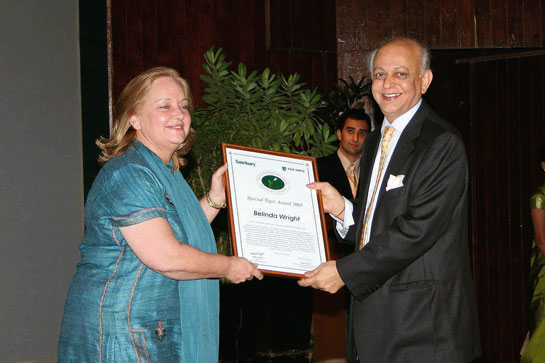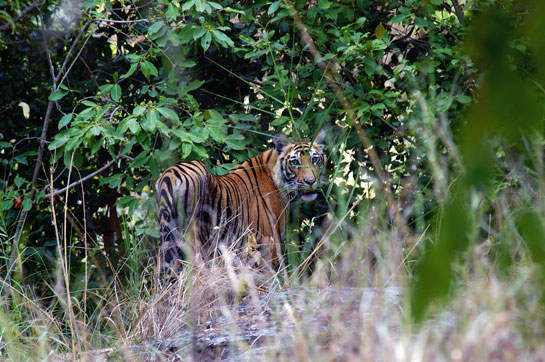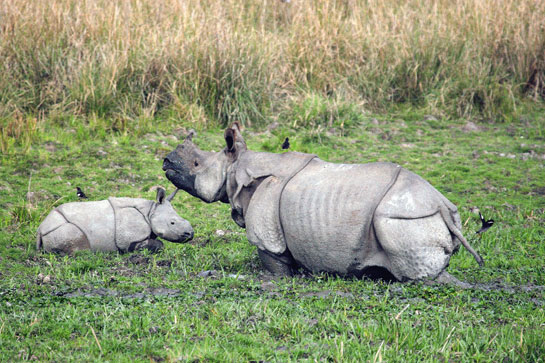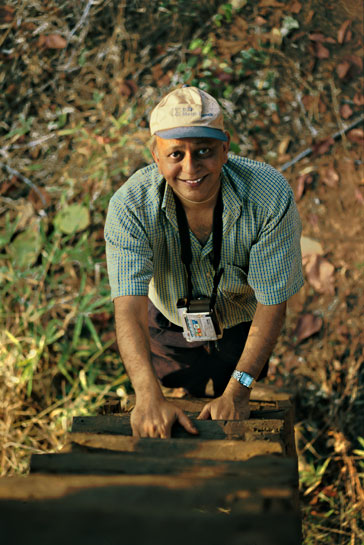Meet Hemendra Kothari
First published in Sanctuary Asia,
Vol. 29
No. 6,
June 2009
Photo: Bittu Sahgal.
Known in financial circles as one of India's most trusted and accomplished investment bankers, the Chairman of DSP Merrill Lynch Ltd., Hemendra Kothari, has a lesser-known facet to his personality - a passion for tigers and wildlife. He speaks here with Bittu Sahgal about his concern for the future of the tiger, about climate change and the ever-present battle between developers and environmentalists.
You seem happier here (standing next to the reclining Shesh Shaiya statue in the Bandhavgarh Tiger Reserve) than in your corporate office in Mumbai. How come you don't take more time out for yourself?
(Smiling) I sometimes ask the same question. But it is not easy. There are responsibilities. I am trying to cut down the usual 12-hour financial day, but after a lifetime of work, it takes time to let go.
How long has this interest in wildlife been a part of you?
For decades. But earlier, I was like any other tourist… out to have a good time. Kruger, Masai Mara, Botswana, Tadoba, Corbett, Kaziranga, Pench, Kanha, Ranthambhore… I went to such places to relax and to take my mind off my work. I feel very differently about wildlife now. Wildlife has given me so much. I now want to give something back.
How do you intend to do that?
By doing whatever I can to help protect the tiger and its forests and encourage others, including corporate bodies, to help. After all, if they take something away to build their businesses, they must also agree to give back. This does not only mean giving money, but also helping lands to regenerate naturally for wildlife to flourish. The government cannot succeed on its own. If prominent people are involved, the message percolates through the system. I started the Wildlife Conservation Trust (WCT) with like-minded friends to add some strength to the conservation movement.
What is WCT's key agenda?
Our purpose is to work with wildlife NGOs, state and central governments and local communities. We do not claim to be experts, but our best efforts go towards providing resources to wildlife experts. Due to lack of proper communication, well-intentioned efforts sometimes fail. So we try to set up meetings between policy makers and experts. Our job is to supplement and further the effort of credible NGOs, if and when the need arises. Protecting wildlife is a very tough job and the field staff needs modern transport, better communication network and dignified facilities for their families. It is also vital that villages that volunteer to move away from critical wildlife habitats are enabled to do so.
What about the welfare of communities living just outside our wildlife habitats?
We must find a way to satisfy their legitimate livelihood needs. But it is equally vital to ensure that such livelihood needs do not come at the cost of the wild animals and forests next to which they live. This means, for instance, that they should be able to sustain themselves through protecting, not killing wildlife or clearing forests as is often the case. I am not saying this is an easy task, but all the concerned people - NGOs, forest officers and policy makers - must sit together with villagers living around wildlife areas and find a way to make them the prime beneficiaries of tourism. They should also profit from global carbon credits if marginal farms are allowed to regenerate back to forest status. NGOs have to take the initiative to make this happen by working closely with state and central governments.
All this costs money and suggests a huge paradigm change in wildlife conservation.
Yes. Different strategies are needed to protect wildlife. But we cannot think of substituting the government. All we can do is to try and supplement national wildlife objectives and give a helping hand. But money is not the only issue. Awareness is equally, if not more, vital. Its about understanding the value of wildlife and forests. If someone understands that rivers obtain water round-the-year from forests, we may not have to work so hard to convince people.

Photo: Bhushan Pandya.
You mentioned getting help from other corporate bodies, but right now many of them are actually stripping our forests for all manner of industrial projects.
Look Bittu, a new modern India is emerging - and nobody can stop that. It is one thing to feel good about publicly criticising someone, but does this do any good? In my opinion, conservationists have to change their strategy. By taking confrontationist or extremist stances, even the little help that is available will not be there.
Where is the extremism? We are not asking for factories to be shut down, we are merely saying that natural India should now be off limits and that we should manage our affairs from natural lands that have already been taken over.
For that we have laws and they should be strictly implemented to keep everyone in line. But you sometimes make the mistake of expecting others to love wildlife as much as you. Once clearance is obtained for a project, then people should not try to stall projects using extra-constitutional means as this raises costs and sets up barriers to future cooperation.
That is the problem. Environmentalists say that the Ministry of Environment and Forests bends and even breaks laws to benefit businessmen with political contacts.
Then they can go to the courts. We are a democracy. Once a project is a fait accompli, why waste energy fighting it. If instead cooperation is achieved, the interests of wildlife will be better served. But this is very difficult for you all to understand. If we want to really act effectively, we have to find the courage to build trust between the government, sincere and knowledgeable NGOs, local communities and responsible members of the corporate sector whose strength is under-utilised for wildlife right now.
You saw the film ‘An Inconvenient Truth'. How important is the climate change issue to India?
Nothing is more important. We have to stop and then reverse climate change. Our agriculture, industry, health and economic future depend on whether we fail or succeed to check climate change. Two-thirds of Indias one billion people depend on agriculture, and cropping patterns will be severely affected by climate change.
Is India on track?
At least, we are talking about it. But I wish we were acting faster. Frankly, we need to do much more to educate businessmen, politicians and bureaucrats. Many are not even aware of what climate change is or its potential impact. But we need a national consensus on this and the Confederation of Indian Industries (CII), the Federation of Indian Chambers of Commerce (FICCI) and other such industrial bodies must participate in an open discussion on the subject of ecological security and national development. I think the Intergovernmental Panel on Climate Change (IPCC) has given us a very clear picture and its Chairman Dr. Rajendra Pachauri, who also heads The Energy Research Institute (TERI), has done a great job of raising both concern and awareness on the issue. This knowledge must translate itself into action by offering incentives and subsidies for solar and wind energy, mass rapid transportation, etc.
But is India a serious player? Are we able to influence global climate change action effectively?
As of now, no one can be said to be really effective. It is common knowledge that developed countries have been mostly responsible for the climate crisis all these years. But this does not mean India should sit back and do nothing while blaming them. It is in our own interests to move fast and decisively. Developed nations must transfer technology to counter climate change for next to nothing to India and China to help lower our carbon emissions. If developed and developing economies work at cross-purposes and indulge in the blame game, wars will be fought because of water and food famines caused by climate change. This may happen sooner than we think. Perhaps, within a decade.

Photo: Meethil Momaya.
Talking about China, it is probably the single greatest threat to tigers in the world today.
Yes, the use of tiger bones and body parts to treat ailments could cause the extinction of wild tigers. People do not understand this. They think that by breeding tigers in cages, they can save the species. This is a totally wrong way to look at the issue. Captive tigers cannot be reintroduced into the wild as they need to learn how to hunt and survive from their mothers. The position taken by India against farming tigers is absolutely correct. But to handle this issue, we need diplomacy at the highest level with bilateral talks and behind-the-scenes negotiations. In my experience, mere confrontation will not succeed.
So are there more Sariskas in India's future?
The way we are going now, yes. But with so little real effort, we can prevent this. I think the Rajasthan Government is now very serious about returning tigers to Sariska, but before that we must ensure that the reason for which the tigers were killed are tackled. I spoke with the Chief Minister who is also very keen to protect tigers, wildlife and forests in Rajasthan. She has passed down instructions and the initial steps to return security to Ranthambhore and Sariska are being taken. I understand that the plan to offer a fair relocation package has been prepared. Facilitating such voluntary shifts is going to be a critical wildlife-conservation strategy in the days to come.
You feel this is a key to the return of tigers?
Yes. If we can provide effective isolation for the tiger from humans, we can save it. But it is not only villagers that are a problem. We must also motivate our forest staff and officers and encourage them. Of course, they have resource limitations. So there is no use criticising officials without ensuring they have proper facilities and budgetary support.
I agree with you, but as I see it the new Forest Rights Act could destabilise all such plans.
From what I hear, there are many loose ends that leave the Act open to exploitation. I think if a sensible approach is made with the government, many of the most dangerous clauses can be tackled. I do not think anyone wants our forests to be lost or degraded, particularly when the role of such forests in moderating global climate has been so clearly proved.
So what is the best way to get the country behind the task of saving the tiger?
Awareness. I am very happy that Sanctuary has taken up one vital task and that is to work with children through Kids for Tigers in cities and around tiger reserves. In my view, too few people visit wildlife areas and that's why we have so little support. We need people to fall in love with the tiger and its forests. The tiger will only be saved if we can effectively save its forests. And if we want wildlife habitats protected, I think we must find a way to get politicians and their families to visit sanctuaries and national parks. The game is not only of saving tigers. As you keep saying, the tiger is only the flagship species. With the tiger we save everything in the forest - birds, insects, even plants. This everyone knows, helps to ensure regular water supply by feeding rivers, even after the rains. It is common sense and we have to make this known to everyone including farmers, rural people and even urban dwellers.
Is there any example you can quote in India where forest and wildlife conservation is effective?
Kaziranga. Anyone who has been to Kaziranga will understand in just one day why the wildlife there is safe. There are no villages in the park. Guards have guns and the authority to use them. Politicians and even ordinary Assamese people support strict protection. No one raises a hue and cry if a guard kills a poacher in self-defence. This example has to be followed by other state governments to prevent wood and wildlife poaching. But simultaneously, it is our responsibility to make it possible for people to avail of microfinance for small-scale industries and self-employment. We must collectively work for solutions. And we must ask ourselves, if as a nation we are doing enough for those working in the field, whether as officers or ground staff.

Photo: Jayanth Sharma.
I think you will find most people will agree with you. How did all this start? Can you describe your most moving wildlife experience?
I think it was probably late one evening in Tadoba five years ago… I was with the Field Director in his vehicle near a fire line after we had gone on an inspection to the outskirts of the park. As we parked our vehicle, we saw a tigress with her three full-grown cubs walk directly towards us in the bright light of the full moon. That was one of the incidents that convinced me that I had to do something for Indias tigers, wildlife and forests.
Admit it! Basically you are in love with tigers!
Its not just me. My entire family is in love with tigers, including my late wife. We still take as many holidays as possible in tiger forests, and I find that spending time by myself in forests renews my spirit and soul. The tiger is powerful, but it does not display aggression needlessly. I would like to make sincere efforts to save tigers in the wild and their forests.





